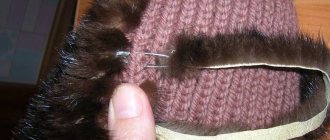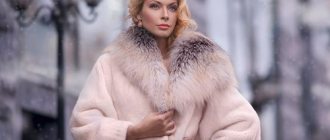Who is Wolverine? What kind of animal is this?
Wolverine is a predator from the mustelidae family. This is a rather strange animal, resembling either a small bear or a big cat. It lives only in the wild, as it does not reproduce in captivity. The wolverine is found in northern Eurasia and North America.
Wolverine - the hyena of the North
Is wolverine fur warm?
Wolverine fur coats are the warmest. The fur of this animal is thick, and the pile is so smooth that even ice crystals cannot catch on to it. It is no coincidence that clothes made of wolverine fur are often found among people whose profession involves constant exposure to frosty air.
Wolverine skin vest
The optimal heat transfer of fur allows you to maintain something like a special microclimate under clothing.
Performance characteristics
A wolverine fur coat is not only incredibly warm, but also a real record holder for durability. For a high-quality sewn product, the fur of this predator lasts 20 seasons, but this is not the limit.
In addition, such a fur coat is easy to use, since its pile is very wear-resistant. You can wear such clothes in any weather.
Disadvantages of Wolverine Fur
Wolverine fur coats have one drawback, which stems directly from their exclusivity. These fur coats are extremely rare to find on sale. And those that are sold in all kinds of fur salons and boutiques have exorbitant prices.
Wolverine skin processing
The wolverine inhabits almost the entire forest zone of our country and is rare throughout this territory. In the mustelidae family it is the largest representative. Its appearance bears little resemblance to other animals. The variation in the length and color of the fur on its skin plays an important role in this.
Color and sizes
The skins can reach a length of 90 cm, with a width of 25-30 cm, and it is difficult to confuse them not only with other types of fur-bearing animals, but also with related ones. The winter fur of the animal is thick, long, quite coarse and lush. Due to the fact that the hair does not fit tightly, the appearance of a shaggy animal is created. The guard hairs are short only on the head and paws; on the rest of the body they are very long and reach 120-150 mm. The fluff is not very thick and does not fall off.
The tail is short, but very bushy and, thanks to the very long hair, reaching 250 mm, it appears very thick.
1
Wolverines have unique skins not only due to the length and lushness of their fur, but also due to their interesting coloring. Most of the muzzle is dark brown; on the forehead there is a light whitish spot, sometimes with a yellowish tint. On the nape and ridge there is a large oval dark spot called the “saddle”.
Starting from the neck, then along the sides of the body and hips there are two light stripes. Narrow and dimly defined in front, closer to the tail they become larger and lighter. This pattern is called a “harness”. The rest of the part, located below the harness, has a dark brown color. The part of the tail where the harness goes is light-colored, the rest is similar in color to the saddle. There are often white spots of various shapes on the neck and chest.
Geographical variability in the predator is weakly expressed, so there is no division into ridges
Color groups
Depending on the color of the saddle and harness, they are divided into three groups:
1) Dark brown (European part of the country and Western Siberia).
The saddle is dark brown. The harness is narrow, not clearly defined, quite dark and slightly different in color from the saddle.
2) Brown (Eastern Siberia).
The saddle is dark brown. The harness is well defined and can be quite wide. Its color shades vary from light brown to sand color.
3) Light brown (Kamchatka).
The saddle is noticeably smaller than previous species and is brown or light brown in color. The harness is very wide and light. Its color ranges from yellow-cream to whitish.
The animal sheds twice during the year - in spring and autumn.
Characteristics and assessment of fur by season
First grade (winter).
Skins with high and thick fur. The awn is frequent and shiny, the down is well developed. Leather fabric is clean.
First grade, medium defect (early spring).
The hair is slightly overripe and slightly thinning on the nape and sides. The mesra is thickened, but without blueness.
First grade, large defect (spring).
Skins with very overripe, thinning, dull fur. The skin tissue is rough and thickened.
Non-standard (late spring, summer, early autumn).
During spring molting, the hair on the skins begins to fall out and is replaced by growing summer hair. The mesra is thickened and dark. In summer, the skins have low and sparse fur. There is practically no fluff. The mesdra is thickened and rough. In the initial stage of autumn molting, a new, still very low, coat of hair replaces the remains of the summer one. The skin tissue is thickened and has a dark blue color.
Third grade (autumn).
The fur on the skins is low, only half grown. The awn is short and shiny. The mesdra is thickened and blue.
Second grade (late autumn).
The hair on the skins is shiny, thick, slightly lower than winter hair. The leather tissue is slightly thickened and has a slight blue tint.
Processing requirements
The skins are removed with a tube, preserving the tail and paws with claws. The paw pads are saved if you plan to make a stuffed animal. During primary processing, special attention is paid to degreasing.
2
Furs are trimmed according to the following rules:
- wedge-shaped No. 1, - forked No. 1, - sliding No. 1.
Editing is done with the fur facing out, maintaining a width to length ratio of 1:4. Fresh-dry canning.
Defects and value of fur
The main defects on wolverine skins are lumbago, damage to fur and leather tissue by the arcs of traps, holes and tears made by forest inhabitants. During initial processing, cuts and tears rarely occur, because the animal’s skin is very thick and durable. Poor low fat content is much more common. Sometimes prelins form due to improper storage.
Wolverine fur has a special property that no other animal species has - it does not turn frosty even in very severe frost. Presumably, this is possible due to the fact that the fur is very fluffy and does not mat. Due to this original property, hats and collars are sewn from skins.
The wolverine is very rare in all areas of its range, and it is also very cautious. That's why hunters rarely catch it. Currently, the skins of this animal are in great short supply. Their cost can be estimated at approximately 4000-5000 thousand rubles.
What kind of fur coats are made from wolverine? Models, colors
The fur of this animal is very coarse, and the skin is thick and inflexible. It is almost impossible to find any particularly elegant wolverine models.
This fur is worn by both men and women. For the male gender, slightly elongated short fur coats, or something like jackets with a turn-down English collar, are sewn. Or you can find long straight fur coats on sale.
Women also do not have a particular variety of styles due to the specific nature of the fur. Usually these are short sheepskin coats or fur coats just above the knee. Without a hood or belt, only with straight sleeves.
Wolverine fur is also often used for finishing other clothing items: jackets, dresses, accessories, etc.
Such fur is not dyed, since it is valuable precisely for its natural color. Typically it ranges from dark chestnut to almost black. On the sides there are characteristic stripes of a milky or caramel yellow hue.
Decor of clothes with wolverine fur
Due to the fact that wolverine fur is very thick and long, products made from it are quite heavy, so for ladies they mainly sew sheepskin coats and other short outerwear models, or use fur as a trim and in accessories. Lush shiny fur makes a thing much more impressive, so it is often used to trim not only coats and jackets, but even dresses. In addition to the coarseness and heaviness of the pile, the disadvantages of fur include the uniformity of color, because fur is almost impossible to dye, so products made from it can differ only in style.
Products made from wolverine fur are of particular interest to lovers of extreme types of entertainment and recreation. Despite the fact that the popularity of wolverine fur is growing every day, its price is still quite affordable. I take into account the fact that this animal is not bred in nurseries and does not live in most countries; its cost is still higher than some other furs.
With love, Editorial Board YavMode.ru
How to care
A wolverine fur coat does not require any special care. In the warm season, she needs to be provided with a proper storage place treated with moth repellents. Periodically you need to take it out and shake it a little.
The wolverine fur coat does not suffer even from being in the pouring rain. Water does not linger on it and simply flows off in an instant.
What does a wolverine eat?
Photo: Wolverine in the snow
Wolverines prey on both small and fairly large animals. Its diet is very rich and varied; the animal is not picky about food. Wolverine is very resilient and can pursue his victim for a long time, depriving him of his last strength. There were times when she overpowered a large elk, which she drove into a snowdrift, where it got stuck. Wolverine does not hesitate to pick up carrion from other predatory animals. She finds out about it by warily listening to the hubbub of the ravens who have flown in for the feast.
Wolverine's victims are often weakened or sick animals. She, like a tireless cleaner, frees the territory from weak animals and carrion. Wolverine catches musk deer, mountain sheep, forest deer, and roe deer. Usually it pursues individuals that are already wounded or weakened by disease. The numbers speak for themselves; it is known that out of a dozen ungulates, the wolverine eats seven of them after larger predators, and catches three on its own.
Wolverine is not averse to eating small rodents, hares, squirrels, and hedgehogs. If it eats small prey instantly, then it divides the carcass of large prey into several parts. What he can no longer eat, he hides in secret storage rooms, which he places underground, between rocks, and under the snow. It is known that the animal can eat a musk deer carcass in approximately four days. So, ungulates and carrion left over from large predators make up the wolverine’s winter menu. Its large and strong jaws easily chew even very frozen food.
In summer, the diet of the predator is more varied, it includes:
- various birds and their eggs;
- fish delicacies;
- mice, snakes, lizards, frogs;
- insect larvae (mainly wasps);
- nuts, berries and even honey.
Sometimes, though very rarely, it happened that wolverines united in packs for more productive hunting. This has been seen in Siberia and the Far East, where there are large numbers of musk deer. Wolverines have long noticed that she escapes from the enemy by running in a circle. Because of this, smart animals came up with a certain hunting tactic: one wolverine chases a musk deer, chasing it in circles, and its other accomplices wait until this circle closes and the victim has no chance.
Although the wolverine is not so fast, its speed is sometimes not enough to quickly catch up with its prey, but this mighty beast has more than enough endurance! Wolverine can pursue the chosen victim for a very long time, killing him and completely exhausting him; he has a lot of patience and power in this matter.
Reviews
A wolverine fur coat is not a cheap thing. Not every woman can afford such a new thing. Let's see what kind of feedback she received from her owners.
Liliya, 47 years old: “We live in the north, so buying a fur coat is a matter of principle for my husband and me. In winter, the outside temperature often drops below 40 degrees. And it gets even colder. We accidentally came across a wolverine fur coat in an expensive fur salon and took it on credit. However, we didn’t regret it at all. The fur coat is warm, beautiful, and looks like a real treasure. Besides, she doesn't care. I think that a wolverine fur coat is a very profitable investment.”
Valeria, 37 years old: “I’ve been wearing a short fur coat made of wolverine for three years now.
This is a truly cool and beautiful fur coat. It can be worn in any cold weather, wearing almost a T-shirt. She's incredibly warm. In addition, it looks expensive, so it is also suitable for going out. Wherever you go, all eyes instantly converge on the fur coat.” [Total: 1 Average: 5/5]
CONTROL METHODS
3.1. Sampling - according to GOST 9209.
3.2. Determination of the mass fraction of moisture - according to GOST 938.1.
3.3. Determination of welding temperature - according to GOST 17632.
3.4. Determination of pH of aqueous extract - according to GOST 22829.
3.5. The area of the skin is determined by multiplying the results of measuring its length from the middle between the eyes to the base of the tail by the width measured in the middle of the skin.
Measurements are made with a metal ruler. The measurement result is rounded to 1.0 dm2. (Changed edition, Amendment No. 1).
Features of character and lifestyle
Photo: Wolverine in winter
Wolverine can be called a loner and a nomad who never sits in one place and travels tens of kilometers a day in search of food. The animal does not move too fast, but tirelessly. Zoologists have noticed cases when a wolverine walked more than 70 km without stopping. The marked territory of a wolverine can reach an area of up to 2000 km. Males do not tolerate other males invading their domain, and they do not drive away females.
The wolverine does not have a permanent home; it can stop to rest in any place: between the roots of large trees, in hollows, in rock crevices, and simply in a snowdrift. Only when a wolverine is preparing to become a mother does it build itself something like a bear’s den, the length of which can be tens of meters.
The animal usually goes hunting at dusk and is more awake at night. A keen sense of smell, excellent eyesight and sensitive hearing help her in this. The animal leads a secretive lifestyle, tries to stay away from human settlements, constantly listens and is cautious. The wolverine's character is fearless and daring. The brave beast does not hesitate, even when in front of him there is an animal that is several times larger in size than the wolverine itself. The wolverine's appearance may appear slightly sullen and angry. These predators are not sociable and drive competitors away from their territory by showing their bestial grin and emitting a muffled roar.
Any element is subject to the wolverine: it perfectly makes its way through the deepest snowdrifts, climbs any trees perfectly, and swims remarkably well. Wolverine is not only unusually brave, has a hardy, steely character, but is also smart and cautious. The animal can move completely unnoticed along human paths or the paths of other predatory animals in order to discover something tasty. Wolverine sometimes ruins the winter quarters of hunters, stealing their prey directly from traps. The wolverine does not have a specific daily routine; it sleeps when it feels tired, regardless of the time of day. This is such a brave, restless, hardy, slightly reckless and unsociable predator!
Reproduction and raising of offspring
Sexual maturity in wolverines occurs at 2-3 years of their life. Females mature a little earlier and are ready for motherhood when they reach 2.5 years, and males begin to show interest in the opposite sex when they turn 3 years old.
Mating season
The rutting period for wolverines is quite extended, it begins in March and ends with the arrival of October. The instinct of reproduction makes these animals forget about their solitary life for a while, and with the onset of February they begin to search for a marriage partner. Furry predators signal their readiness to mate in a banal, but most effective way: they leave odorous marks everywhere from their anal glands, which serve as a signal that the wolverine is free and ready to procreate.
A pair of wolverines hunting together
By the way, males, in whose territory several females live, do not even need to bother looking for a mate. They simply take turns visiting all the females from their personal “harem”, spend about a week and a half with each of them, and return to their free life with a sense of accomplishment.
The most amazing thing is that after the birth of the cubs, the new fathers always visit their heirs, bring them gifts, and sometimes even, together with the female, teach them hunting and survival lessons.
Well, those male representatives who have not yet acquired their own harem have to engage in battles with their competitors. After all, several gentlemen are vying for one free female, and only the strongest and most worthy will receive the right to become the father of her cubs. Battles between wolverines are not for the faint of heart. To win, males use all available means, inflicting lacerations on the enemy with their teeth and razor-sharp claws, so deaths after their fights are not at all uncommon.
Duration of pregnancy and childbirth
The general gestation period for wolverines is 4 to 8 months. And this, at first glance, strange period of time has a completely logical explanation. The fact is that after fertilization, the embryo does not develop, but “falls asleep” in the egg, waiting for the right moment. Around the end of January, the embryo emerges from the latent state and literally in 30-40 days forms into a full-fledged fetus.
Newborn wolverine cubs
Wolverine cubs are born in February or early March. In one litter there are from 2 to 4 puppies, they are born blind and helpless, weighing no more than 100 g. The eyes of newborns open after 4 weeks, but for another 2 months the babies will remain in their den, under the vigilant supervision of their mother.
A refuge for the animals are abandoned burrows of other animals, or even holes dug right in the snow, the bottom of which the expectant mothers carelessly line with pieces of moss and branches. Puppies grow up in truly Spartan conditions, because wolverines do not even bother themselves with arranging a comfortable and cozy maternity nest, from the very beginning preparing their offspring for the fact that their life path will be difficult and harsh.
Caring for the Cubs
Wolverines are not the most reverent and affectionate mothers, but they approach raising their offspring with full responsibility. Females understand that their main task is to convey to their babies all their experience of survival, and to teach them that there is no place for tenderness and unnecessary sentimentality in their lives. Naturally, wolverine mothers fiercely protect their puppies from any threat, but at the same time they are not inclined to show them their affection and love.
Grown-up kids are waiting for their mother from the hunt
Recommended by topic
Cranes Anaconda Tiger
The cubs are breastfed for up to 3 months, then the female switches them to a diet of semi-digested meat. At six months of age, young wolverines will have their first hunting lesson. After all, around the middle of summer, they finally leave their den, and, accompanied by their mother, begin to explore the world around them, learning useful skills along the way.
Kids must firmly grasp such knowledge as hunting, methods of protection from enemies, how to take game from a stronger predator, as well as the most important life lesson - how not to become a victim of a person and avoid his insidious traps.
The cubs remain close to their mother almost until they reach adulthood, that is, 1.5-2 years. After this, their paths diverge, and the young wolverines begin their wandering life, wandering through the taiga, in search of their own territory and places for hunting. And only time will tell how exemplary students they were, and whether they successfully comprehended the science of survival.
Question to the expert
Is it possible to tame a wolverine?
Complex issue. It's not very often that people manage to catch a live wolverine, so few zoos can boast of such a rare and valuable exhibit. Zoologists have not yet been able to fully study the character and habits of these animals, so no one really knows how to tame them. There is information that wolverines, raised from a young age, quickly got used to humans and did not show their characteristic anger and aggression. But adult individuals, captured in the taiga and forcibly placed in a cage, cannot be tamed, and are distrustful even of those zoo employees who feed them and clean their homes.






